Abstract
Radioactive isotopes (7Be, 210Pbatm and 137Cs) are used as indicators of processes associated with the transfer of matter from the atmosphere. Studying snow cover can provide information about the seasonal deposition flux of the isotopes to the Earth’s surface over the entire period of snow accumulation. The purpose of this study is to identify the features of 7Be, 210Pbatm and 137Cs deposition with the atmospheric precipitation in winter in the Arctic part of Western Siberia and to study the contribution of the particulate fractions of suspended matter in snow water to the total content of the radionuclides in samples of integrated seasonal snowfall. Snow samples were taken over a wide area along the highways around Novy Urengoy in April 2019. The suspended matter in snow samples was divided into three fractions. The isotopic composition was determined by high-resolution semiconductor gamma-spectrometry. The seasonal deposition flux of 7Be and 210Pbatm in the winter at the time of sampling averaged 58.7 and 25.2 Bq m−2 season−1, respectively. The average specific activity of 7Be and 210Pbatm in the snow water was 248.0 and 104.5 mBq L−1. The deposition flux of 137Cs from the atmosphere was low compared to 7Be and 210Pbatm and did not exceed 0.39 Bq m−2 season−1 at all sampling points. This indicates an insignificant modern flux of the radionuclide from the atmosphere. The separation of suspended matter in snow water by particulate fractions shows that the studied isotopes are present in all the extracted fractions: >3, 0.45–3 and <0.45 μm. The main part of 210Pbatm in all studied samples is in the coarse-grained fraction >3 μm. Most 7Be is contained in finely dispersed aerosols, colloids, or a dissolved component (where the fraction <0.45 μm). A significant increase in the contribution of coarse-grained fractions of suspended matter in snow water to the total activity of 7Be in snow precipitation was observed in territories with a higher anthropogenic impact.
1. Introduction
One of the main transport pathways of chemical elements in the environment is through the atmosphere. This process can be significantly affected by both natural (dust storms, volcanic activity and forest fires) and anthropogenic (emissions from industrial enterprises, open pit mining, storage of industrial waste and accidents at the enterprises of the nuclear fuel cycle) factors. Chemical elements transported by air enter the Earth’s surface as a part of dry dust-aerosol deposition, as well as in atmospheric precipitation (wet deposition).
Often, radioactive isotopes such as 7Be, 210Pbatm and 137Cs are used as indicators of processes associated with the transfer of matter from the atmosphere. They are used, for example, in assessing the conditions and rates of formation of modern lake, river and sea sediments and in studying the transport of aerosol particles in the atmosphere and the rates of their precipitation on the Earth’s surface [1,2,3,4,5,6,7,8,9,10,11,12]. In the study of the radionuclide composition of aerosol and dust particles, atmospheric deposition is a subject of many modern investigations [13,14,15,16,17,18,19].
Naturally occurring radioactive isotopes 7Be and 210Pbatm reach the Earth’s surface from the atmosphere in significant quantities. These isotopes have various sources of origin: 7Be (T1/2 = 53.3 days) is formed in the upper atmosphere through the spallation reactions of the protons and neutrons of cosmic rays with 14N and 16O nuclei [4,20]. About 75% of the total 7Be is produced in the stratosphere (10–47 km) and 25% in the upper troposphere (8–10 km) [21,22]. 210Pb (T1/2 = 22.3 years) is a daughter product of 222Rn. Radon is formed as a result of the radioactive decay of radionuclides of the 238U series and enters the atmosphere from the Earth’s surface. An additional amount of 210Pb near large settlements and land transport highways can enter the atmosphere by burning leaded fuels. However, in Russia the use of such fuel has been universally banned in the last decade, the contribution of this component can be neglected. The emission of 137Cs (T1/2 = 30 years) into the environment occurred mainly as a result of testing nuclear weapons and accidents at nuclear power plants. Currently, 137Cs enters the atmosphere mainly as a result of several processes: the weathering of dust particles from the surface of previously contaminated soils, or the combustion of a large amount of organic material during strong natural fires [23,24,25]. Being electrically charged immediately after formation, these radionuclides are sorbed by aerosol and dust particles and fall to the Earth’s surface. According to Ioannidou [26], “the activity size distributions of the radionuclides attached to aerosol particles are the result of atmospheric process combinations, e.g., the coagulation of ultrafine particles, fog and cloud droplet formation, evaporation and condensation, washout, rainout and the contribution of dust storms and combustion products to the tropospheric aerosol mixture”. Moreover, some estimates [14,15,27,28,29] show that more than 80% of total flux of 7Be and 210Pbatm on the Earth’s surface is associated with wet precipitation (snow and rain).
There is a large number of studies related to the investigation of processes regulating the behavior of 7Be and 210Pbatm in the air and their washout from the atmosphere as a part of rainfall. At the same time, there are few works devoted to the study of 7Be and 210Pbatm in snow. Such studies may be especially relevant for regions where a long (more than several months) period of stable negative temperatures with the formation of a constant snow cover is characteristic. Very few studies in the literature are presented containing information on 7Be and 210Pbatm in freshly fallen snow [30,31,32,33]. For example, the average specific activity of 7Be and 210Pb in fresh snow at two sites of Greenland were 13.48 and 1.08 pCi kg−1 (Dye 3) [31], 12.06 and 1.32 pCi kg−1 (Summit) [30], respectively. There are practically no widely known data on studies of the joint seasonal atmospheric flux of 7Be and 210Pbatm, based on the study of integrated snow samples accumulated in winter periods in a given territory. Snow cover is a natural depository, accumulating information on atmospheric flux for a sufficiently large period of time from the first precipitation in late autumn to its melting in spring. Its study can provide information on the total flux of 7Be and 210Pbatm to the Earth’s surface over the entire period of snow accumulation without separation of the dry or wet components. Such a vast region as Western Siberia, located in the northern part of central Eurasia, remains completely unexplored from this point of view. The territory of Western Siberia from the south and north is defined to 49° and 73° North latitude and from west to east, 60° and 90° East longitude. The duration of the annual steady snow cover for this territory varies from 4 to 5 months in the South to 8–9 months in the North in the Arctic zone.
Previous studies [17] have allowed us to obtain a preliminary estimate of the amount of 7Be, 210Pbatm and 137Cs entering the Earth’s surface as a part of the snowfall in the southern regions of Western Siberia. In fresh snow precipitated and sampled on this territory in the 2016–2017 winter period, specific activities of 210Pbatm and 7Be were 506 ± 45 and 1611 ± 130 mBq L−1, recalculated to the volume of snow waters. In fresh rain waters (the spring–autumn period of 2017), these values were 242 ± 23 and 2434 ± 200 mBq L−1, respectively. The average value of the 7Be/210Pbatm activity ratio in fresh rain waters was more than three times higher than in fresh snow: 10.1 to 3.2. The study of integrated snowfall accumulated over the five months of the winter of 2016–2017 showed that the maximum deposition densities of 7Be and 210Pbatm were observed in a foothill zone—618 ± 62 and 171 ± 17 Bq m−2, respectively. The minimum values corresponded to the Alpine zone—104 ± 11 and 27 ± 4 Bq m−2. The forest-steppe zone deposition densities of 7Be and 210Pbatm varied within 237–340 Bq m−2 and 73–93 Bq m−2. The deposition density of 137Cs in comparison with 210Pbatm and 7Be was small and did not exceed 1 Bq m−2 in all studied points.
As a rule, 7Be, 210Pbatm and 137Cs are found in rain and snow waters as a part of the suspended matter, which is a complex mixture of terrigenous particulate materials of different natures and sizes. It is based on dust particles of soil, fine sand, organic plant debris with a size of 10–103 μm, fine clay, aerosol particles of an 10−1–102 μm size, nanosized aerosol particles and colloids. Earlier, we showed [17] that 7Be and 210Pbatm are present in all particulate fractions of suspended matter in snow water, representing samples of snowfall in the south of Western Siberia. Moreover, the highest 7Be/210Pbatm ratio is observed in the finest fraction represented by nanosized aerosol particles, colloids and the dissolved component.
The purpose of this study is to identify the features of the 7Be, 210Pbatm and 137Cs deposition as a part of the atmospheric precipitation in winter in the Arctic part of Western Siberia (Yamal-Nenets Autonomous District (YNAD) of Russia), as well as to study the contribution of particulate fractions of suspended matter in snow water to the total content of radionuclides in the samples of integrated seasonal snowfall.
2. Materials and Methods
2.1. Objects of Research
In this work, we studied integrated snow samples taken from 18 to 22 April 2019 in the Nadym, Purov and Taz regions of the Yamal-Nenets Autonomous District. Figure 1 shows the layout of the sampling points. The sampling was carried out along the following highways: Nadym–Novy Urengoy–sat. Urengoy and sat. Tazovsky–sat. Urengoy–Tarko–Sale, representing the west–east and north–south directions. Sampling points are located at a distance of 100–200 m from the roads. Geographically, the investigated area is comprised of tundra and forest–tundra landscape zones. As a rule, there are lichens, mosses, poorly developed grass cover and undersized shrubs (dwarf birch, juniper, blueberry, etc.) on the soil surface. The forest–tundra zone is characterized by the presence of a sparse forest, represented mainly by larch, Siberian cedar and pine. The collected integrated snow samples are material accumulated from mid-October 2018 to the end of April 2019 and consisting of a mixture of wet (snow) and dry (dust, aerosol) precipitation.
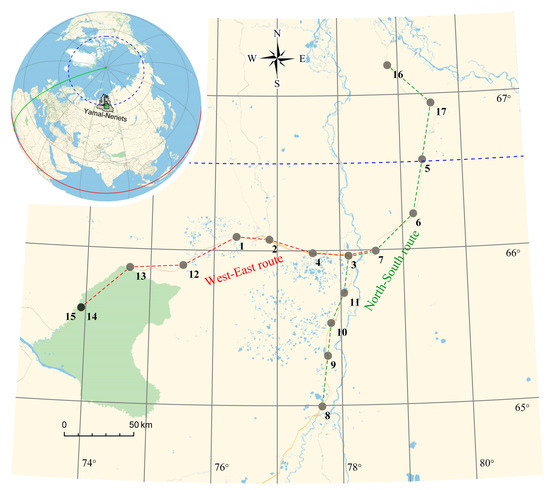
Figure 1.
Map of integrated snow sampling in the Arctic part of Western Siberia.
2.2. Sampling and Sample Preparation Technique
Surface areas located in the open air within zones closed from strong winds were selected for snow sampling. Samples were taken for the entire thickness of the snow cover, with the exception of the 5 cm layer above the soil. A brief description of the sampling sites is presented in Table 1. Snow samples with a volume of 50–60 L were packed in plastic containers and delivered to the laboratory. The final sample preparation consisted of several successive stages: snow samples were melted under laboratory conditions at room temperature. Suspended matter of the sample was decanted. To separate finely dispersed solid fractions, the decanted solution was successively filtered through two filters: a blue ribbon filter (average pore size of 3–5 microns) and a membrane filter of 0.45 microns. This made it possible to separate two components of suspended matter with a dimension of more than 3 μm and from 3 to 0.45 μm, which are dust particles of various sizes. The solution obtained after filtration was acidified to pH = 1 by the addition of concentrated HNO3. The solution contained a suspended substance with a dimension of less than 0.45 μm, represented by nanosized dust, aerosol particles, colloids and a dissolved component. The entire volume of the solution was evaporated until a dry residue was isolated. Subsequently, the content of the gamma-emitting radionuclides was determined in the selected dry residue and filters.

Table 1.
Register of samples taken from the Arctic part of Western Siberia in 2019.
When studying the elemental composition of water samples, an important step is the acidification of samples immediately after sampling. Acidification is carried out to minimize losses due to sorption on the walls of laboratory glassware. As a rule, in many studies related to the study of the elemental and radionuclide composition of wet deposition, acidification was carried out either at the stage prior to the precipitation accumulation [1,5,19] or immediately after sampling [34]. This approach excludes the possibility of identifying the contribution of the coarse-grained dust component of the suspended matter to the total content of chemical elements. Our preliminary studies showed that acidification to pH = 1 immediately after melting causes up to 90% of 7Be, 210Pbatm and 137Cs contained in the coarse fractions of suspended matter to pass into the dissolved component. The aim of our investigation is to study the contribution of different particulate fractions of suspended matter in snow water to the total content of the studied radionuclides. Therefore, we slightly changed the generally accepted approach. To reduce the effect of the sorption of radionuclides on the walls of the laboratory glassware, the time of Steps 1–3 was reduced to the minimum possible. After completion of the filtration procedure, all used laboratory glassware was thoroughly washed with an acid solution (pH = 1, distilled water and HNO3 in a ratio of 1000:1). The resulting flushing was added to the solution to be evaporated.
2.3. Analysis
In the isolated particulate fractions of the suspended matter of each snow sample, the activities of 7Be, 210Pbatm and 137Cs were determined by high-resolution semiconductor gamma spectrometry using a specially developed procedure [35,36].
The analysis was performed using a gamma spectrometer based on the low-background well-type HPGe detector GWL-220-15 (active volume: 220 cm3; well diameter: 15.5 mm; well depth: 40 mm; resolution: better than 1.4 keV at energy 122 keV and better than 2.3 keV at energy 1.33 MeV). This detector has a large working volume and, thanks to the presence of a well inside the active zone, allows for measurements with a geometry close to 4π. This equipment made it possible to measure the intensity of gamma lines in the range of 30 to 2000 keV. The detector efficiency for the 46.5 keV (210Pb) and 661.7 keV (137Cs) gamma-lines was calculated using an in-house calibration source prepared by spiking extremely low radioactive material (high-purity quartz, coal and sawdust) with the Russia national silicate reference sample of uranium ore (UR 47S) and soil reference sample prepared by the International Atomic Energy Agency (IAEA-375). The detector efficiency for the 477.6 keV (7Be) peak was determined using a linear interpolation between the 351.9 keV (214Pb) and 661.7 keV (137Cs) photo-peaks of the same standards. When placing a sample weighing from 0.5 to 8 g inside the well, the detection efficiency of the gamma rays with an energy of 46.5 keV reached a value of 50–60%, with 477.6 keV, it reached 15–20% and with 661.7 keV, it reached 7–8%. The procedure took into account the influence of such interfering factors as the density of the analyzed samples and the measurement geometry. The accuracy of analysis was estimated against the BIL-1, BIL-2, ZUK-1, SDO-1, SG-1A, DVG, DVT and DVR Russian national standards, the IAEA-375 and IAEA-135 standards.
The lower detection limit of 7Be, 210Pbatm and 137Cs was 0.02 Bq. The duration of the measurement of a single sample varied from 12 to 48 h. Time was chosen so that the statistical error in determining the areas of analytical photopeaks of 46.5 and 477.6 keV did not exceed 5%.
2.4. Backward Trajectory Frequency Analysis
To determine the potential long-distance transport pathways of air masses reaching YNAD, five-day backward air-mass frequency trajectories were computed using the Hybrid Single-Particle Lagrangian Integrated Trajectory (HYSPLIT) model [37]. The meteorological data used for trajectory calculating were the GDAS (Global Data Assimilation System) data (1° × 1°) and were downloaded from the web server of NOAA Air Resources Laboratory. We obtained a total of 770 daily trajectories started every 6 h at 500 m above ground level (AGL) from 9 October 2018 to 19 April 2019, which can be grouped into five clusters via the built-in clustering tool in the model.
3. Results and Discussion
The results of determining the values of specific activities and seasonal deposition fluxes of 7Be, 210Pbatm and 137Cs in the studied snow samples are presented in Table 2. The specific activities of particulate fractions are given in terms of snow water volume units. The radionuclide seasonal deposition fluxes at each point were calculated based on the known data of the sampling area and the amount of snow water obtained by melting snow (Table 1). All data were recalculated to the time of sampling. Taking into account the short half-life of 7Be (53.2 days) and a long duration of the snow cover accumulation period (~186 days), the actual value of 7Be total flux in winter will be significantly higher. In this case, the necessary decay and buildup corrections during the accumulation period must be implemented. According to Aba et al. [13] the correction factor (1/Ks) applied during the time of snow cover accumulation is defined as follows:
where T1/2 is the 7Be half-life and ts is the snow cover accumulation time.

Table 2.
Seasonal deposition fluxes and specific activities of the studied radionuclides in the snow samples.
Estimated values for the total winter fluxes of 7Be, calculated with the correction factor (1/Ks), are also shown in Table 2. It should be noted that these values do not consider a number of factors that affect the accurate value of the total flux: the duration, intensity and time distribution of individual snowfall events; possible significant differences in the concentrations of 7Be in the snow of each event, and others.
The obtained results show that the studied isotopes were present in all the extracted particulate fractions of suspended matter in snow water: from large dust particles to nanosized aerosol particles, colloids and the dissolved component.
Summing the contribution of all extracted particulate fractions of suspended matter, the seasonal deposition fluxes of 210Pbatm, 7Be and 137Cs associated with wet and dry depositions precipitated over the entire period of accumulation of snow cover on the studied territory, and calculated to the time of sampling, can be averaged as follows (Bq m−2 season−1): 25.2 (varied from 12.0 to 50.1), 58.7 (27.4–118.0) and 0.20 (0.05–0.39), respectively. Using the correction factor (1/Ks), the actual value of 7Be total flux in winter can be estimated at the level of 156.1 (72.8–313.7) Bq m−2 season−1. The average specific activities of 7Be, 210Pbatm and 137Cs in snow water at the time of sampling are 248.0 (147.5–357.2), 104.5 (70.8–139.9) and 0.90 (0.14–1.82) mBq L−1, respectively. In further interpretations, we will operate with the values of 7Be activities determined at the time of sampling.
The seasonal deposition flux of 137Cs is low and does not exceed 0.40 Bq m−2 season−1 at all studied sampling points. This indicates an insignificant modern flux of this radionuclide from the atmosphere. It should be noted that the levels of 137Cs concentrations in the studied samples are close to the detection limit of the analytical method used. The error of 137Cs determination often exceeds 30%, which makes it impossible to make high-quality joint statistical interpretations of 137Cs data and data obtained for 210Pbatm and 7Be.
Figure 2 shows the dependences of 7Be and 210Pbatm specific activities and seasonal deposition fluxes on the calculated amount of precipitation at the sampling points. The graphs show the absence of a significant correlation between the specific activities of both isotopes and the amount of precipitation. At the same time, the seasonal deposition fluxes of 7Be and 210Pbatm strongly correlate with the amount of precipitation at the correlation coefficients (r) of 0.75 and 0.88, respectively. Such strong correlations are explained by the fact that washout with precipitation is one of the most important mechanisms for removing these isotopes from the atmosphere. It is known that more than 80% of 7Be and 210Pbatm located in the lower atmosphere are deposited directly with wet precipitation (rain and snow) [14,15,27,28,29].
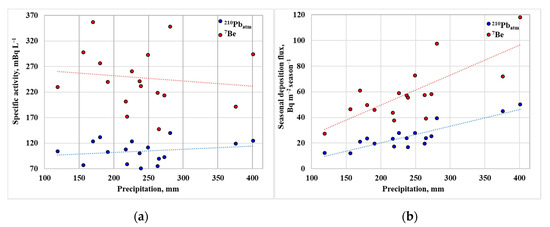
Figure 2.
Dependence of specific activities (a) and seasonal deposition fluxes (b) of 7Be and 210Pbatm on the calculated amount of precipitation at the sampling points.
The study of the nature of the joint deposition of 7Be and 210Pbatm (Figure 3) shows a noticeable correlation (the Pearson correlation coefficient, r = 0.55) between the values of their specific activities. There is a strong correlation between the seasonal deposition fluxes of 7Be and 210Pbatm (r = 0.86). This suggests that the deposition of both radionuclides is regulated by the same processes (cloud height, the extent and duration of snowfall, the intensity of snowfall, cloud type and the vertical mixing of the air masses at the sampling location) [15,38,39].
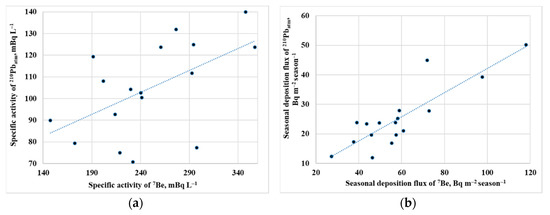
Figure 3.
Correlation of (a) specific activities of 7Be and (b) its seasonal deposition fluxes with 210Pbatm in integrated snow samples at the time of sampling.
The spatial distribution of 7Be and 210Pbatm seasonal deposition fluxes at the sampling points is shown in Figure 4. It should be noted that the seasonal deposition fluxes of both 7Be and 210Pbatm in the latitudinal direction are generally higher than in the meridional direction. The seasonal deposition fluxes of 7Be from north to south vary from 27.3 to 58.8 Bq m−2 season−1 and those of 210Pbatm vary from 12.4 to 27.9 Bq m−2 season−1, with average values of 47.3 and 21.0, respectively. In the direction from west to east, these values vary from 37.7 to 118.1 Bq m−2 season−1 (7Be) and from 12.1 to 50.1 Bq m−2 season−1 (210Pbatm), with average values of 69.0 and 29.1, respectively.
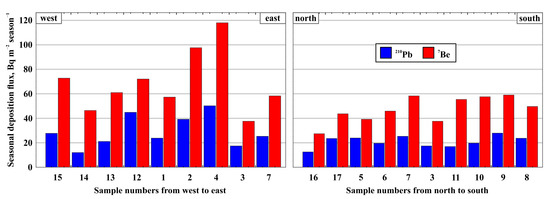
Figure 4.
Spatial distribution of 7Be and 210Pbatm seasonal deposition fluxes at sampling points.
Figure 5 shows the spatial distribution of 7Be and 210Pbatm specific activities at the sampling points. The specific activity values of 7Be at the latitudinal direction sampling points (268 mBq L−1) are higher than the meridional (219 mBq L−1). The specific activities of 210Pbatm in both directions have close values (108 and 98 mBq L−1). The activity ratio of 7Be/210Pbatm varies from 1.6 to 3.8, with average values of 2.5 and 2.2.
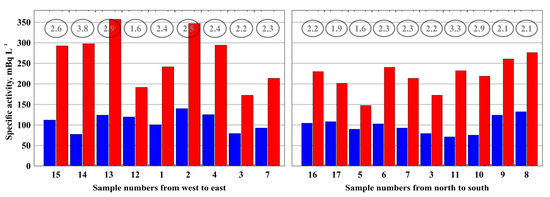
Figure 5.
Spatial distribution of specific activities of 7Be and 210Pbatm at sampling points depending on longitude and latitude.
When studying the radionuclide composition (7Be and 210Pbatm) of the particulate fractions of suspended matter in snow water, the following features were revealed (Table 3 and Figure 6):

Table 3.
The contribution of particulate fractions (%) of suspended matter in snow water to 7Be and 210Pbatm total activity.

Figure 6.
Averaged values of the suspended matter in snow water particulate fractions contribution (%) to the total activity of 7Be and 210Pbatm.
- (a)
- The studied isotopes are present in all particulate fractions.
- (b)
- The main part of 210Pbatm in all studied samples is the coarse-grained fraction and varies in the range of 47.0–87.1%, with an average value of 63.3%. The contribution of this fraction to the 7Be total activity is lower (6.7–76.7%, with an average value of 29.7%).
- (c)
- The contribution of suspended matter with a fraction size from 3 to 0.45 μm to the total activity is small and averages 11.4% (6.3–18.0%) for 210Pbatm and 5.7% (1.8–17.9%) for 7Be.
- (d)
- Most 7Be is contained in the structure of finely dispersed aerosols, colloids, or the dissolved component (fraction size <0.45 μm)—64.6% (15.9–90.3%).
The average values of 7Be and 210Pbatm specific activities in the suspended matter in snow water particulate fractions, calculated over the entire set of studied samples, are presented in Figure 7. The fraction >3 μm contains 73.7 mBq L−1 (7Be) and 66.2 mBq L−1 (210Pbatm). Values of the 0.45–3 μm fraction are equal to 14.1 and 11.9 mBq L−1, and those of the <0.45 μm fraction are equal to 160.2 and 26.4 mBq L−1.
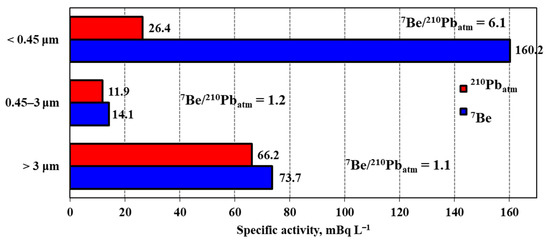
Figure 7.
Average values of 7Be and 210Pbatm specific activities in the particulate fractions of suspended matter in snow water.
For coarse-grained fractions, consisting mainly of large dust particles, the 7Be/210Pbatm ratio is equal to 1.1–1.2. The 7Be/210Pbatm ratio of the finely dispersed fraction is much higher—6.1. The low values of the 7Be/210Pbatm ratio typical for coarse-grained fractions could indicate that these particles represent the material whose radionuclide composition was formed long before its entry into the atmosphere and subsequent precipitation onto the Earth’s surface as a part of dry deposition and snowfall. In this case, the low content of 7Be can be explained by its short half-life. It could also be that dust particles raised into the air from the surface as a result of various atmospheric processes initially contain increased concentrations of non-equilibrium 210Pb. Their sorption ability might have been insufficient for significant accumulation of 7Be when particles were in the atmosphere. There is most likely an influence by both of these. The high value of 7Be/210Pbatm ratios in the finest fraction, despite the significant influence of the 7Be radioactive decay process, confirms the fact that the finely dispersed aerosol component is the carrier concentrator of this isotope.
Figure 8 shows that there are five pathways for air masses to arrive at YNAD from their distant sources during winter period. The cluster-mean 5-day backward air-mass trajectories analysis suggested that air masses over Novy Urengoy are mostly from Kazakhstan (20%) and the western region of Russia (20%). Air masses originating in Kola Peninsula, Greenland and Canada accounted for 16%. Trajectories from the Ob estuary and Novaya Zemlya accounted for 26% and the north of the Krasnoyarsk Territory and Yakutia for 18% of the total trajectories. It should be noted that the direction of air masses coming from southern regions with an arid and semi-arid climate to the steppe and semi-desert landscape-geographical zones can make a significant contribution to the total volume of dust particles brought to the Novy Urengoy region. Accordingly, this direction can have an important effect on the regional, not related to local sources, content 210Pbatm and the 7Be/210Pbatm ratio.
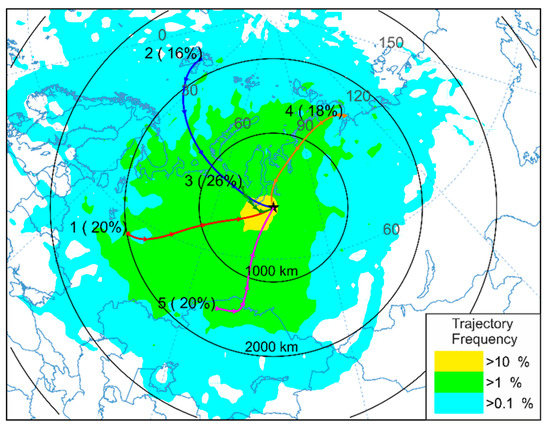
Figure 8.
Cluster-mean 5-day backward air-mass trajectories calculated by the HYSPLIT model, including the percentages of each cluster trajectory during 2018–2019 winter period.
Figure 9 shows histograms characterizing the contribution of the particulate fractions of suspended matter in snow water to 210Pbatm and 7Be total activity in snow samples taken in the latitudinal direction from west to east. Two groups of points are distinguished by the contribution of coarse-grained fraction 1 (>3 μm) to the total activity of 7Be. The first group (Group 1) includes samples numbered 1–4 and 13, where the part of Fraction 1 is greater than 34%. The second group (Group 2) includes samples numbered 7, 12, 14 and 15, with a lower (<19%) contribution of this fraction. At the same time, the main part (48–87%) of 210Pbatm of all samples is concentrated in Fraction 1.
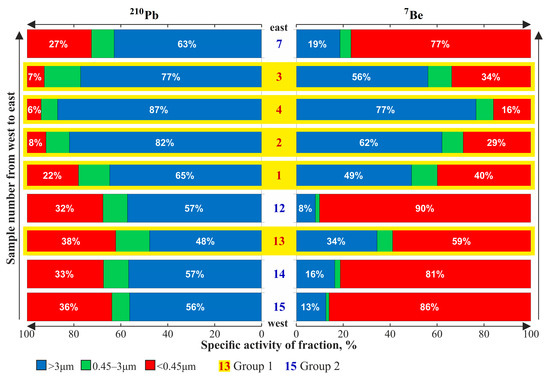
Figure 9.
The contribution of particulate fractions (%) of suspended matter in snow water to the total activity of 210Pbatm and 7Be, sampled from west to east in the territory of Yamal-Nenets Autonomous District (YNAD).
According to the same criterion (Figure 10), among the samples taken in the meridional direction (from north to south), Group 1 includes Samples 3 and 8, in which the contribution of the coarse-grained Fraction 1 of the suspended matter in snow water to 7Be total activity is equal to 54–56%. In the remaining samples (Group 2), 68–90% of the 7Be is concentrated in the finely dispersed Fraction 3 (<0.45 µm). In all samples, the main part (47–77%) of 210Pbatm is concentrated in the coarse-grained Fractions 1 and 2.
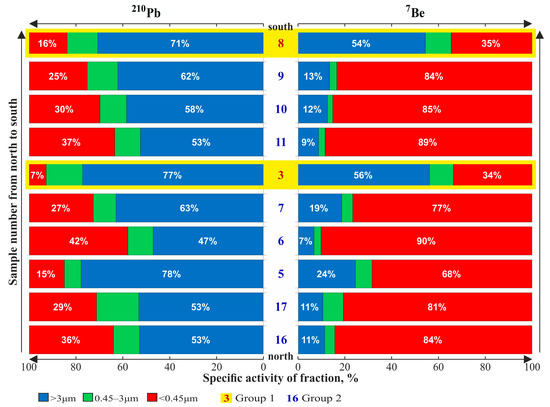
Figure 10.
The contribution of particulate fractions (%) of suspended matter in snow water to the total activity of 210Pbatm and 7Be, sampled from north to south in the territory of YNAD.
A distinctive feature of the samples belonging to Group 1 and Group 2 is the territorial location of the sampling points. All samples representing Group 1 were selected near settlements. Sampling Points 1 and 2 are located on the eastern and western borders of the Novy Urengoy city in the immediate vicinity of the industrial zone. Sample 3 was taken on the western outskirts of the Korotchaevo town, which is a large transport center located 60 km east of Novy Urengoy. Sampling Site 4 is located between Korotchaevo and Novy Urengoy downwind from highways and railways with heavy traffic. Point 8 is located 120 km south of Korotchaevo in the immediate vicinity of the administrative center Tarko-Sale. Sampling Site 13 is located 100 km west of Novy Urengoy, near the large settlement Pangody. All these localities have thermal power stations, large industrial transport companies, a transport network and a number of industrial enterprises. The presence of a developed industrial and social infrastructure implies an increased atmospheric emission of a significant amount of pollutants in the form of dust material and fuel combustion products (smoke and soot) in the winter. The release of such emissions with 7Be/210Pbatm ratios other than natural values, on the one hand, creates additional conditions for the sorption of 7Be and 210Pbatm in the air; on the other hand, it increases the amount of solid substance entering the Earth’s surface as a part of dry and wet precipitation, accumulating in integrated snowfalls in the immediate vicinity of formation places. Thus, we can say that the snow sampling sites belonging to Group 1 are located in areas with an increased anthropogenic impact. In contrast to Group 1, Group 2 sampling sites are located far (at least 30–40 km) from settlements and are less affected by the anthropogenic factor. It appears that such an attitude is characteristic of dusty material arriving with snowfall from the southern and south-western directions.
Figure 11 presents the averaged data characterizing the distribution of 7Be and 210Pbatm over the particulate fractions of the suspended matter in snow water from the samples of Group 2. This group is characterized by a low contribution of coarse fractions (1 and 2) to the total 7Be content, which is on average about 16%. The main part (~84%) of 7Be is present in the finely dispersed Fraction 3 consisting of nanosized aerosol particles and colloids. 210Pbatm is characterized by a different distribution in particulate fractions: its main fraction (~69%) is present in Fractions 1 and 2 and only 31% is included in Fraction 3. We should pay attention to the difference in the values of 7Be/210Pbatm ratios. This value is 6.3 in the finely dispersed Fraction 3. Regarding the coarse-grained fractions, this ratio is below 1:0.5 in Fraction 1 and 0.8 in Fraction 2. It appears that such an attitude is characteristic of dusty material arriving with snowfall from the southern and south-western directions.
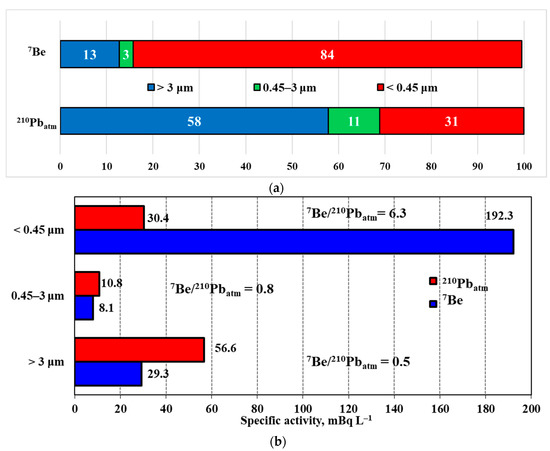
Figure 11.
Averaged values of particulate fractions contribution (%) to total activity (a) and specific activities (b) of 210Pbatm and 7Be in suspended matter in the snow water of Group 2 samples.
The distribution of 7Be and 210Pbatm by particulate fractions of suspended matter in snow water for Group 1 samples taken near settlements (Figure 12) differs significantly from Group 2 samples located far from settlements. In Group 1 samples, on average, only 36% of 7Be is found in Fraction 3. This is significantly less than the 84% corresponding to Group 2. A higher contribution of coarse-grained fractions to the total activity is also observed for 210Pbatm. About 84% of this isotope is concentrated in Fractions 1 and 2. The contribution of the finely dispersed fraction decreases to 16%. The 7Be/210Pbatm ratio is indicative. The value of Fraction 3 (5.3) is close to the value (6.3) observed in Group 2 samples. The 7Be/210Pbatm ratios of the coarse-grained fractions reach 1.8–1.9. This is three times higher than in Group 2. The close values of the 7Be/210Pbatm ratios observed for Fractions 1 and 2 in both groups of samples suggest that the nature of the accumulation of these isotopes in dust particles, which vary in a very wide range from 0.45 to hundreds of µm, is the same under the same conditions.
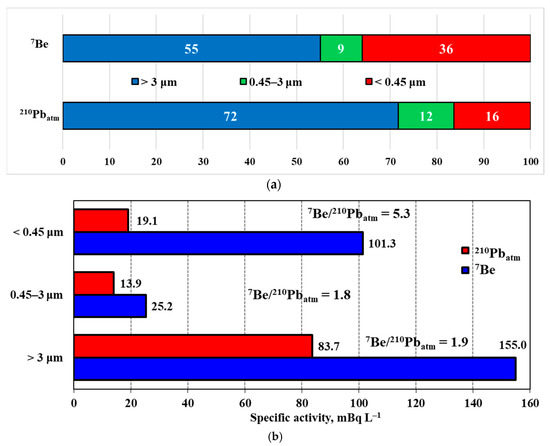
Figure 12.
Averaged values of the particulate fractions contribution (%) to the total activity (a) and specific activities (b) of 210Pbatm and 7Be in suspended matter in the snow water of Group 1 samples.
The samples of Group 1 and Group 2 differ not only in the contributions of different fractions to the total activity of 7Be and 210Pbatm in snow waters. Significant differences are also observed in the specific activities of these fractions, calculated per unit of snow water volume (Figure 11 and Figure 12). The specific activity of 7Be in the finely dispersed Fraction 3 in the Group 1 samples (101.3 mBq L−1) is almost two times lower than that in the Group 2 samples (192.3 mBq L−1). In the coarse-grained fractions, the opposite picture is observed—higher specific activities in Group 1. This difference reaches a threefold level in Fraction 2 (25.2 and 8.1 mBq L−1). In Fraction 1, this difference is the most significant—more than five times (155.0 and 29.3 mBq L−1). Regarding 210Pbatm, these differences are not so significant, but the general trend remains the same. The specific activity of 210Pbatm in Fraction 1 of the Group 1 samples (19.1 mBq L−1) is 1.6 times lower than in Group 2 samples (30.4 mBq L−1). In Fraction 2, this ratio is 0.78 (13.9 and 10.8 mBq L−1), and in Fraction 3, it is 0.68 (83.7 and 56.6 mBq L−1). Despite significant differences in the redistribution of 7Be and 210Pbatm activities between particulate fractions of suspended matter in the samples of different groups, their total activities in snow waters differ, but not so substantially. The total specific activity of 7Be in the Group 1 samples (281.6 mBq L−1) is 1.23 times higher (229.6 mBq L−1) than it is in Group 2. Regarding 210Pbatm, this value is 1.19 (116.7 and 97.8 mBq L−1). Thus, it can be stated that, in samples from areas with an increased anthropogenic impact, the specific activities of 7Be and 210Pbatm in suspended matter in snow water are on average 20% higher than in samples from clean areas.
The division of the studied samples into groups according to the territorial location of their sampling sites can be clearly seen in the scatter diagrams constructed in the coordinates of the 7Be and 210Pbatm activities. Figure 13 shows the scatter diagrams of 7Be and 210Pbatm in specific activities and seasonal deposition fluxes for the coarse-grained Fraction 1 of the suspended matter in snow water. On both graphs, two areas of points are clearly distinguished, corresponding to the Group 1 and Group 2. In the samples of Group 1, a strong correlation was observed both between specific activities (r = 0.95) and between the seasonal deposition fluxes (r = 0.99) of 7Be and 210Pbatm. Correlations in Group 2, despite a noticeable linear trend in the distribution of points on the scatter-plots, are much lower. The correlation coefficient of specific activities is only 0.13. The correlation of seasonal deposition fluxes is more significant (r = 0.45). If we consider the entire set of points, including both groups, as a whole, then the correlation between 7Be and 210Pbatm in both specific activities and seasonal deposition fluxes is very high at r = 0.82 and r = 0.85, respectively.
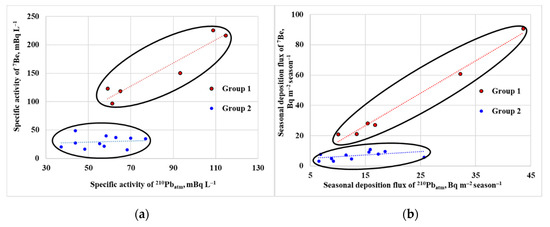
Figure 13.
Specific activities (a) and seasonal deposition fluxes (b) of 210Pbatm and 7Be in the coarse-grained Fraction 1 (>3 μm) of suspended matter in snow water.
The samples of Group 1 and Group 2 can be confidently identified in Fraction 2 of suspended matter in snow water. In the 7Be-210Pbatm scatter diagrams shown in Figure 14, two regions corresponding to the indicated groups can also be distinguished. As in the case of Fraction 1, Fraction 2 is characterized by a high correlation between the seasonal deposition fluxes of 7Be and 210Pbatm in the Group 1 samples. The correlation coefficient in this case is r = 0.94. In Group 2, this correlation is low (r = 0.37). No strong correlation was observed in the specific activities of 7Be and 210Pbatm in Fraction 2. The correlation coefficients are 0.47 in Group 1 and 0.55 in Group 2. As regards the whole set of points, including both groups, the correlation between 7Be and 210Pbatm in both specific activities and seasonal deposition fluxes is low at r = 0.56 and r = 0.50, respectively.
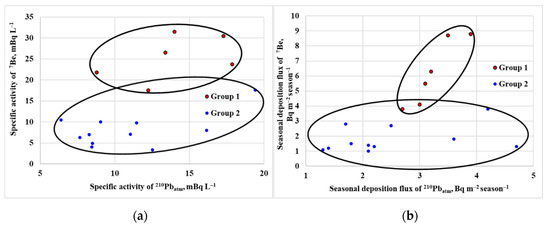
Figure 14.
Specific activities (a) and seasonal deposition fluxes (b) of 210Pbatm and 7Be in Fraction 2 (3–0.45 μm) of suspended matter in snow water.
In the 7Be-210Pbatm scatter diagrams corresponding to the finely dispersed Fraction 3 of suspended matter in snow water (Figure 15), it is not possible to reliably separate the Group 1 and Group 2 samples. It can be noted that the bulk of Group 1 points are concentrated in the lower parts of the graphs. Due to Point 13 falling sharply out of the general sequence (7Be = 210.6; 210Pbatm = 46.8 mBq L−1), a very high correlation between the specific activities of 7Be and 210Pbatm (r = 0.96) was observed in Group 1. The correlation coefficient of seasonal deposition fluxes in the Group 1 samples is slightly lower (r = 0.83). A lower correlation of specific activities (r = 0.57) and fairly high for seasonal deposition fluxes (r = 0.82) were observed in the Group 2 samples. As in the case of the coarse-grained Fraction 1, regarding the entire set of points of Fraction 3, which includes both groups, there is a high correlation between 7Be and 210Pbatm in both specific activities and seasonal deposition fluxes at r = 0.81 and r = 0.85, respectively.
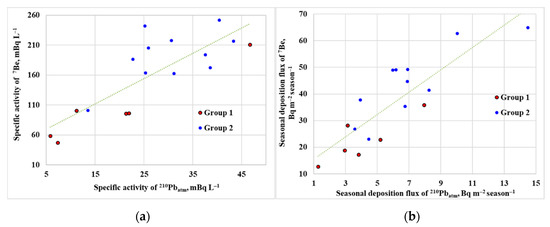
Figure 15.
Correlation of (a) specific activities of 210Pbatm and (b) its seasonal deposition fluxes with 7Be in the finely dispersed fraction (<0.45 μm) of suspended matter in snow water.
Thus, there is a significant increase in the contribution of coarse-grained fractions of suspended matter in snow water to the total activity of 7Be in snow precipitation falling in areas with increased anthropogenic impact. It has been shown by Papastefanou and Ioannidou [40] that “in the activity size distribution of ambient aerosols, 7Be is shifted to large particle sizes in the presence of pollutants. Removal of small aerosol particles in the submicron size range of the activity size distribution either by scavenging or by deposition of particles on any surface may result in a depletion of small particles in the activity size distribution. Subsequent 7Be condensation on all aerosols effectively enriches large particles in the activity size distribution”.
4. Conclusions
The study of the radionuclide composition of snowfall accumulated during the winter period of 2018–2019 in the Yamal-Nenets Autonomous District (Russia) made it possible to obtain the first data on the joint deposition of 7Be, 210Pbatm and 137Cs on the Earth’s surface in the Arctic region of Western Siberia.
The seasonal deposition fluxes of 7Be and 210Pbatm in winter, calculated to the time of sampling (late April 2019), averaged 58.7 and 25.2 Bq m−2 season−1. The average specific activity of 7Be and 210Pbatm in snow water was 248.0 and 104.5 mBq L−1, respectively. The median value of 7Be/210Pbatm ratios for the entire set of samples is 2.3 (1.6–3.8). Taking into account decay and buildup corrections during the snow cover accumulation period, the actual value of 7Be total flux in winter can be estimated at the level of 156.1 Bq m−2 season−1. The seasonal deposition flux of 137Cs from the atmosphere was low compared to 7Be and 210Pbatm and did not exceed 0.39 Bq m−2 season−1 at all studied sampling points. This indicates an insignificant modern flux of this radionuclide from the atmosphere.
A correlation was observed between the seasonal deposition fluxes of 7Be and 210Pbatm and the amount of precipitation (r = 0.75 and 0.88). Such high levels of correlation are explained by the fact that washout with precipitation is one of the most important mechanisms for removing these isotopes from the atmosphere. Exploring the nature of 7Be and 210Pbatm combined deposition shows a noticeable correlation (r = 0.55) between the values of their specific activities and a strong correlation between the seasonal deposition fluxes of 7Be and 210Pbatm (r = 0.86).
The separation of suspended matter in snow water by particulate fractions showed that the studied isotopes were present in all the extracted fractions: >3, 0.45–3 and <0.45 μm. The main part of 210Pbatm in all the studied samples was in the coarse-grained fraction >3 μm, with an average value of 63.3%. The part of this fraction in the total activity of 7Be was lower and averaged 29.7%. The contribution of suspended matter with a fraction size from 3 to 0.45 μm to the total activity was small and averaged 11.4% for 210Pbatm and 5.7% for 7Be. Most of the 7Be (64.6%) was contained in finely dispersed aerosols, colloids, or a dissolved component (fraction <0.45 μm). The particulate fractions of the suspended matter of snow waters differed sharply in terms of 7Be/210Pbatm ratios. 7Be/210Pbatm ratios in coarse-grained fractions consisting mainly of dust particles whose sizes range from 0.45 to hundreds of µm took values from 1.1 to 1.2. The 7Be/210Pbatm ratio in the finely dispersed fraction <0.45 μm was significantly higher—6.1. Such high values of the 7Be/210Pbatm ratio in the finest fraction, despite the significant influence of the radioactive decay of 7Be, confirm the fact that it is the finely dispersed aerosol component that is the carrier concentrator of this isotope.
According to the ratio of the contributions of the particulate fractions of the suspended matter in snow water to the total activity of 7Be and 210Pbatm, as well as the specific activities of these isotopes in the fractions, two groups of samples were identified as having a clear territorial location. The sampling points that made up Group 1 were located in areas with a high anthropogenic impact, close to large settlements. Group 2 samples were taken at points located in areas with a smaller anthropogenic impact, far (at least 30–40 km) from the settlements. The main distinctive feature of the Group 1 samples compared to Group 2 was the significantly lower contribution of the finely dispersed fraction <0.45 μm to the total 7Be activity in the suspended matter of snow water: 36% and 84%, respectively. Here, the contribution of the coarse-grained fractions larger than 0.45 μm increased from 16 to 64%. 7Be/210Pbatm ratios in the finely dispersed fractions of both groups were similar: 5.3 (Group 1) and 6.3 (Group 2). The coarse-grained fractions of the Group 1 samples were characterized by higher 7Be/210Pbatm ratios, compared to Group 2: 1.8–1.9 and 0.5–0.8, respectively. Thus, a significant increase in the contribution of the coarse-grained fractions of suspended matter in snow water to the total activity of 7Be in snow precipitation was observed in territories with a higher anthropogenic impact.
Author Contributions
Conceptualization, K.M. and M.M.; methodology, M.M.; validation, K.M. and M.M.; formal analysis, K.M., M.M. and D.B.; investigation, K.M. and M.M.; writing—original draft preparation, K.M.; writing—review and editing, M.M., K.M. and D.B.; visualization, K.M. and D.B. All authors have read and agreed to the published version of the manuscript.
Funding
This work (sampling, analytical work, and the interpretation of results) was supported by the Russian Science Foundation grant (project No 18-77-10039). Analytical studies were carried out at Center for multi-elemental and isotope research SB RAS. The development of a sample preparation technique was done on the state assignment of IGM SB RAS with the financial support of the Ministry of Science and Higher Education of the Russian Federation.
Acknowledgments
The authors gratefully acknowledge Alexsey Shavekin for assistance during the field study at Novy Urengoy. The NOAA Air Resources Laboratory (ARL) for the provision of the HYSPLIT transport and dispersion model and READY website (https://www.ready.noaa.gov) used in this publication. We also gratefully thank the reviewers and academic editors for their constructive comments.
Conflicts of Interest
The authors declare that there is no conflict of interest.
References
- Alonso-Hernández, C.M.; Morera-Gómez, Y.; Cartas-Águila, H.; Guillén-Arruebarrena, A. Atmospheric deposition patterns of 210Pb and 7Be in Cienfuegos, Cuba. J. Environ. Radioact. 2014, 138, 149–155. [Google Scholar] [CrossRef]
- Baskaran, M. Po-210 and Pb-210 as atmospheric tracers and global atmospheric Pb-210 fallout: A review. J. Environ. Radioact. 2011, 102, 500–513. [Google Scholar] [CrossRef] [PubMed]
- Baskaran, M.; Naidu, A.S. 210Pb-derived chronology and the fluxes of 210Pb and 137Cs isotopes into continental shelf sediments, East Chukchi Sea, Alaskan Arctic. Geochim. Cosmochim. Acta 1995, 59, 4435–4448. [Google Scholar] [CrossRef]
- Baskaran, M.; Shaw, G.E. Residence time of arctic haze aerosols using the concentrations and activity ratios of 210Po, 210Pb and 7Be. J. Aerosol Sci. 2001, 32, 443–452. [Google Scholar] [CrossRef]
- Caillet, S.; Arpagaus, P.; Monna, F.; Dominik, J. Factors controlling 7Be and 210Pb atmospheric deposition as revealed by sampling individual rain events in the region of Geneva, Switzerland. J. Environ. Radioact. 2001, 53, 241–256. [Google Scholar] [CrossRef]
- Carroll, J.; Williamson, M.; Lerche, I.; Karabanov, E.; Williams, D.F. Geochronology of Lake Baikal from 210Pb and 137Cs radioisotopes. Appl. Radiat. Isot. 1999, 50, 1105–1119. [Google Scholar] [CrossRef]
- Godoy, J.M.; Schuch, L.A.; Nordemann, D.J.R.; Reis, V.R.G.; Ramalho, M.; Recio, J.C.; Brito, R.R.A.; Olech, M.A. 137Cs, 226, 228Ra, 210Pb and 40K concentrations in Antarctic soil, sediment and selected moss and lichen samples. J. Environ. Radioact. 1998, 41, 33–45. [Google Scholar] [CrossRef]
- Hansson, S.V.; Kaste, J.M.; Chen, K.; Bindler, R. Beryllium-7 as a natural tracer for short-term downwash in peat. Biogeochemistry 2014, 119, 329–339. [Google Scholar] [CrossRef]
- Leppänen, A.-P.; Usoskin, I.G.; Kovaltsov, G.A.; Paatero, J. Cosmogenic 7Be and 22Na in Finland: Production, observed periodicities and the connection to climatic phenomena. J. Atmos. Sol.-Terr. Phys. 2012, 74, 164–180. [Google Scholar] [CrossRef]
- Simon, J.; Meresova, J.; Sykora, I.; Jeskovsky, M.; Holy, K. Modeling of temporal variations of vertical concentration profile of 7Be in the atmosphere. Atmos. Environ. 2009, 43, 2000–2004. [Google Scholar] [CrossRef]
- Taylor, A.; Blake, W.H.; Smith, H.G.; Mabit, L.; Keith-Roach, M.J. Assumptions and challenges in the use of fallout beryllium-7 as a soil and sediment tracer in river basins. Earth-Sci. Rev. 2013, 126, 85–95. [Google Scholar] [CrossRef]
- Yoon, Y.Y.; Dong, C.K.; Kil, Y.L.; Soo, Y.C. Seasonal variation of 7Be and 3H in Korean ambient air and rain. J. Radioanal. Nucl. Chem. 2016, 307, 1629–1633. [Google Scholar] [CrossRef]
- Aba, A.; Al-Dousari, A.M.; Ismaeel, A. Depositional characteristics of 7Be and 210Pb in Kuwaiti dust. J. Radioanal. Nucl. Chem. 2016, 307, 15–23. [Google Scholar] [CrossRef]
- Baskaran, M. A search for the seasonal variability on the depositional fluxes of 7Be and 210Pb. J. Geophys. Res. Atmos. 1995, 100, 2833–2840. [Google Scholar] [CrossRef]
- Baskaran, M.; Coleman, C.H.; Santschi, P.H. Atmospheric depositional fluxes of 7Be and 210Pb at Galveston and College Station, Texas. J. Geophys. Res. Atmos. 1993, 98, 20555–20571. [Google Scholar] [CrossRef]
- Buraeva, E.A.; Davydov, M.G.; Zorina, L.V.; Malyshevskii, V.S.; Stasov, V.V. Content of cosmogenic 7Be in the air layer at the ground at temperate latitudes. At. Energy 2007, 102, 463–468. [Google Scholar] [CrossRef]
- Melgunov, M.; Mezina, K.; Sherbov, B.; Vosel, Y.; Zhurkova, I.; Belyanin, D. Radioactive elements in atmospheric precipitations of the Western Siberia. E3S Web Conf. 2019, 98, 10003. [Google Scholar] [CrossRef]
- Pöschl, M.; Brunclík, T.; Hanák, J. Seasonal and inter-annual variation of Beryllium-7 deposition in birch-tree leaves and grass in the northeast upland area of the Czech Republic. J. Environ. Radioact. 2010, 101, 744–750. [Google Scholar] [CrossRef]
- Taylor, A.; Keith-Roach, M.J.; Iurian, A.R.; Mabit, L.; Blake, W.H. Temporal variability of beryllium-7 fallout in southwest UK. J. Environ. Radioact. 2016, 160, 80–86. [Google Scholar] [CrossRef]
- Lal, D.; Malhotra, P.K.; Peters, B. On the production of radioisotopes in the atmosphere by cosmic radiation and their application to meteorology. J. Atmos. Terr. Phys. 1958, 12, 306–328. [Google Scholar] [CrossRef]
- Johnson, W.B.; Viezee, W. Stratospheric ozone in the lower troposphere—I. Presentation and interpretation of aircraft measurements. Atmos. Environ. 1981, 15, 1309–1323. [Google Scholar] [CrossRef]
- Usoskin, I.G.; Kovaltsov, G.A. Production of cosmogenic 7Be isotope in the atmosphere: Full 3-D modeling. J. Geophys. Res. Atmos. 2008, 113. [Google Scholar] [CrossRef]
- Scherbov, B.L.; Lazareva, E.V. Migration factors of radionuclides and heavy metals during forest fires in Siberia. Adv. Environ. Res. 2010, 4, 125–143. [Google Scholar]
- Shcherbov, B.L. The role of forest floor in migration of metals and artificial nuclides during forest fires in Siberia. Contemp. Probl. Ecol. 2012, 5, 191–199. [Google Scholar] [CrossRef]
- Shcherbov, B.L.; Lazareva, E.V.; Zhurkova, I.S. Lesnyye Pozhary I Ikh Posledstviya, 1st ed.; Akademicheskoye izdatel’stvo «Geo»: Novosibirsk, Russia, 2015; pp. 38–112. [Google Scholar]
- Ioannidou, A. Activity size distribution of 7Be in association with trace metals in the urban area of the city of Thessaloniki, Greece. Atmos. Environ. 2011, 45, 1286–1290. [Google Scholar] [CrossRef]
- Koch, D.M.; Mann, M.E. Spatial and temporal variability of 7Be surface concentrations. Tellus B Chem. Phys. Meteorol. 1996, 48, 387–396. [Google Scholar] [CrossRef]
- Olsen, C.R.; Larsen, I.L.; Lowry, P.D.; Cutshall, N.H.; Todd, J.F.; Wong, G.T.F.; Casey, W.H. Atmospheric fluxes and marsh-soil inventories of 7Be and 210Pb. J. Geophys. Res. 1985, 90, 10487–10495. [Google Scholar] [CrossRef]
- Turekian, K.K.; Benninger, L.K.; Dion, E.P. 7Be and 210Pb total deposition fluxes at New Haven Connecticut and at Bermuda. J. Geophys. Res. 1983, 88, 5411–5415. [Google Scholar] [CrossRef]
- Dibb, J.E. Beryllium-7 and Lead-210 in the atmosphere and surface snow over the Greenland ice sheet in the summer of 1989. J. Geophys. Res. 1990, 95, 22407–22415. [Google Scholar] [CrossRef]
- Dibb, J.E.; Jaffrezo, J.-L. Beryllium-7 and lead-210 in aerosol and snow in the dye 3 gas, aerosol and snow sampling program. Atmos. Environ. Part A Gen. Top. 1993, 27, 2751–2760. [Google Scholar] [CrossRef]
- Davidson, C.I.; Jaffrezo, J.-L.; Mosher, B.W.; Dibb, J.E.; Borys, R.D.; Bodhaine, B.A.; Hillamo, R. Chemical constituents in the air and snow at Dye 3, Greenland—I. Seasonal variations. Atmos. Environ. Part A Gen. Top. 1993, 27, 2709–2722. [Google Scholar] [CrossRef]
- Gaffney, J.S.; Orlandini, K.A.; Marley, N.A. Measurements of 7Be and 210Pb in Rain, Snow, and Hail. J. Appl. Meteorol. 1994, 33, 869–873. [Google Scholar] [CrossRef]
- Renfro, A.A.; Cochran, J.K.; Colle, B.A. Atmospheric fluxes of 7Be and 210Pb on monthly time-scales and during rainfall events at Stony Brook, New York (USA). J. Environ. Radioact. 2013, 116, 114–123. [Google Scholar] [CrossRef] [PubMed]
- Gavshin, V.M.; Melgunov, M.S.; Sukhorukov, F.V.; Bobrov, V.A.; Kalugin, I.A.; Klerkx, J. Disequilibrium between uranium and its progeny in the Lake Issyk-Kul system (Kyrgyzstan) under a combined effect of natural and manmade processes. J. Environ. Radioact. 2005, 83, 61–74. [Google Scholar] [CrossRef]
- Mel’gunov, M.S.; Gavshin, V.M.; Sukhorukov, F.V.; Kalugin, I.A.; Bobrov, V.A.; Klerkx, J. Anomalies of radioactivity on the southern bank of the Ysyk-Köl Lake (Kyrgyzstan). Chem. Sustain. Dev. 2003, 11, 859–870. [Google Scholar]
- Rolph, G.; Stein, A.; Stunder, B. Real-time Environmental Applications and Display system: READY. Environ. Model. Softw. 2017, 95, 210–228. [Google Scholar] [CrossRef]
- McNeary, D.; Baskaran, M. Depositional characteristics of 7Be and 210Pb in southeastern Michigan. J. Geophys. Res. Atmos. 2003, 108, 4210. [Google Scholar] [CrossRef]
- Rastogi, N.; Sarin, M.M. Atmospheric 210Pb and 7Be in ambient aerosols over low-and high-altitude sites in semiarid region: Temporal variability and transport processes. J. Geophys. Res. Atmos. 2008, 113, D11103. [Google Scholar] [CrossRef]
- Papastefanou, C.; Ioannidou, A. Influence of air pollutants in the 7Be size distribution of atmospheric aerosols. Aerosol Sci. Technol. 1996, 24, 102–106. [Google Scholar] [CrossRef]
© 2020 by the authors. Licensee MDPI, Basel, Switzerland. This article is an open access article distributed under the terms and conditions of the Creative Commons Attribution (CC BY) license (http://creativecommons.org/licenses/by/4.0/).